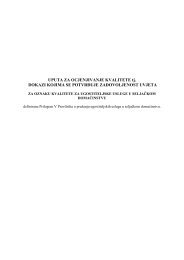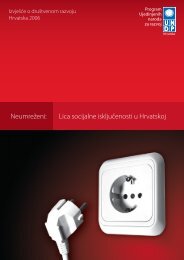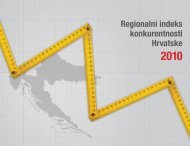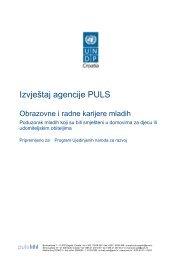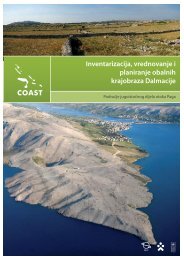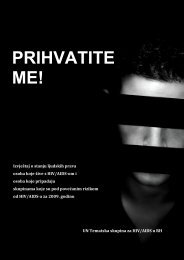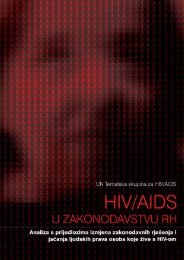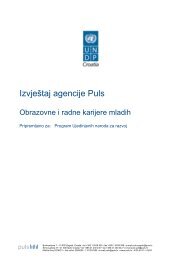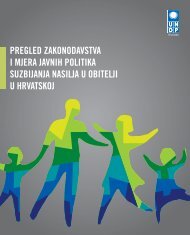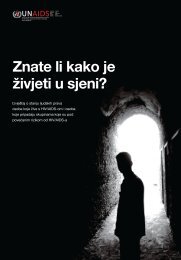WEB engleska verzija end.indd - UNDP Croatia
WEB engleska verzija end.indd - UNDP Croatia
WEB engleska verzija end.indd - UNDP Croatia
- No tags were found...
Create successful ePaper yourself
Turn your PDF publications into a flip-book with our unique Google optimized e-Paper software.
CONCEPT OF SOCIAL EXCLUSIONCHAPTER 1decisive) effect on a country’s ability to improve theirlabour market, combat long-term unemployment,and social exclusion. A diverse institutional system isthe outcome of a complex historical process, whichmaintains the interest and structure of political influencesfrom numerous individuals and social groups.Finally, there are numerous other factors that caninfluence the process of change and contribute toeconomic development or stagnation.1.3 Social Exclusion in <strong>Croatia</strong>Although there is no generally-accepted definitionfor social exclusion, it is by and large taken to be amulti-dimensional phenomenon which weakensthe relationship between the individual and thecommunity. The weakening of this relationship canhave economic, political, socio-cultural and evenspatial impacts. The more ways in which this relationshipis impacted, the more vulnerable an individualbecomes. Exclusion is most commonly visible in thelabour market, the most essential social services, humanrights, and the social safety net. Social exclusionis often linked to unemployment and poverty, butcan be caused by any number of factors.In 2006, the United Nations Development Programme(<strong>UNDP</strong>) in <strong>Croatia</strong> conducted a national research onthe quality of life and the risk of social exclusion. Thequality of life concept was selected because it attemptsto quantify the overall well-being of a society whilefocusing on individuals. It also uses both objectiveindicators (living conditions, income, employment,housing, etc) 11 and subjective indicators (satisfactionwith family life, working conditions, work-life balance,quality of public services and institutions, health conditions,security of immediate environment, optimismabout the future etc). The <strong>UNDP</strong> national survey wasbased on the first quality of life Pan-European surveylaunched in 2003 12 to support common EU objectiveson social policy. The <strong>UNDP</strong> survey facilitated an appropriatecomparison between <strong>Croatia</strong> and the EU MemberStates, which provided a baseline for establishingdevelopmental priorities.The research consisted of three components:a) The Quality of Life Survey (with a sample of 8,534respondents; representative at the county level);b) Survey on social welfare service providers; 13 andc) Focus group discussions with 20 social groupsconsidered to be at risk of social exclusion.The focus groups included individuals with physicaland intellectual disabilities, parents of children withdisabilities, the long-term unemployed, the homeless,returnees, single parents, children without parentalcare, victims of domestic violence, Roma, sexual minorities,the elderly, people with low education levels,and youth with behavioural difficulties. Most of thesegroups were less likely to be represented in a nationalsurvey sample because they have no registered residenceor live in illegal settlements, welfare residentialinstitutions and shelters.According to the three dimensions of social exclusion14 used in the survey, one in ten <strong>Croatia</strong>ns issocially excluded (11.5%). This is approximately thesame percentage of <strong>Croatia</strong>ns (11%) that were foundto be poor in the 2006 World Bank Living StandardAssessment, which points to the tight correlationbetween poverty and social exclusion. However, interms of self-perception, 20% of <strong>Croatia</strong>ns believethey are socially excluded. 15 Social exclusion is directlycorrelated with education, g<strong>end</strong>er, and livingenvironment. People with primary education or lessand even those with only secondary education aresocially excluded more frequently (61.3% and 37.1%,respectively). Women are twice as likely to be socially11 European Quality of Life Questionnaire was used with the permission of the European Foundation for the Improvement of Living andWorking Conditions.12 Pan-European survey includes the EU25 and the three candidate countries (CC3) – Romania, Bulgaria and Turkey.13 Representatives of 200 social service providers were asked about their working conditions and job satisfaction, relationship with theusers, cooperation with other institutions and perceptions of the usefulness of their work and willingness to participate in communitybased services.14 In order to be considered socially excluded, respondents had to be deprived in the following three dimensions: economic (incomeper household member is below 60% of median), labour (the unemployed), and socio-cultural (absence of social participation or tertiarysociability, e.g. non-involvement in voluntary, humanitarian, religious, political organisations or activities)15 This includes respondents who completely or somewhat agreed with the statement: “I feel left out of society“.21



